Types of DNS Records¶
Contents
A Record¶
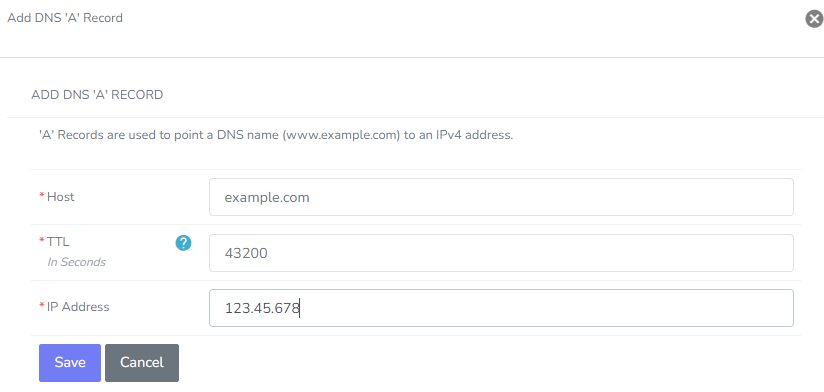
An A record points a domain to an IPv4 address. This is the primary record responsible for directing a domain query in a browser to the correct IP address.
If a domain does not have a resolving A record, the domain will not be viewable in the browser.
Editing or adding a new A record requires the following information:
Host: The domain associated with the record
TTL: The number of seconds that a record will be considered valid by a server caching the information
IPv4: The IPv4 address where the domain should be pointed
AAAA record¶
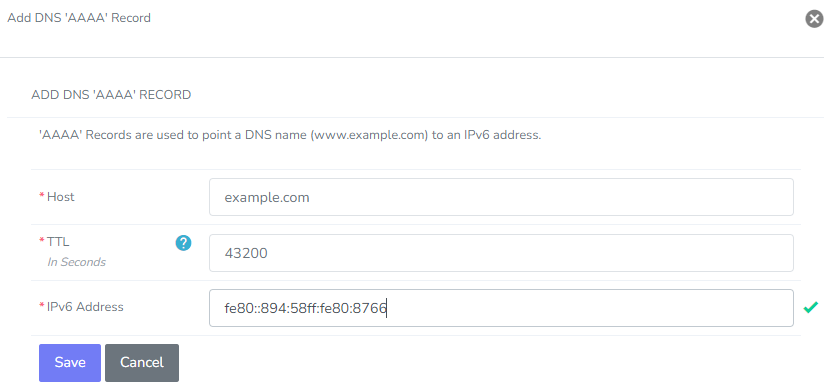
An AAAA record points a domain to an IPv6 address.
Editing or adding a new AAAA record requires the following information:
Host: The domain associated with the record
TTL: The number of seconds that a record will be considered valid by a server caching the information
IPv6: The IPv6 address where the domain should be pointed
NS Record¶
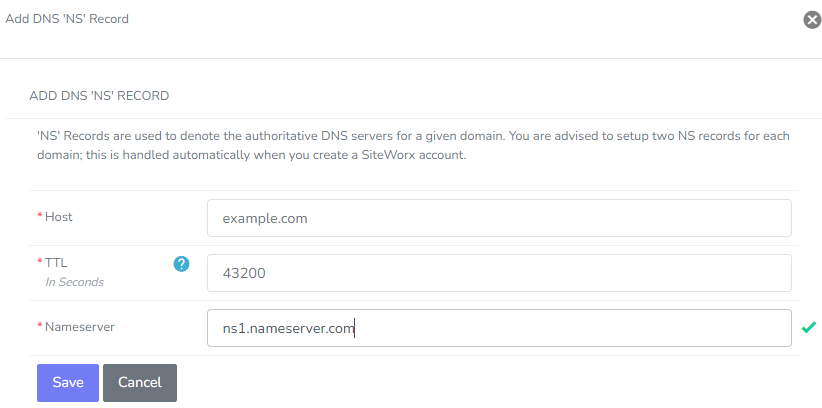
An NS record states the authoritative nameserver for the zone. Nameservers are very important, in that they are where all of the DNS zones and record information for a domain are stored.
If a domain does not have resolving NS records, it will not be able to be viewable in the browser.
Editing or adding a new NS record requires the following information:
Host: The domain associated with the record
TTL: The number of seconds that a record will be considered valid by a server caching the information
Nameserver: The Nameserver that should be associated with the domain
CNAME Record¶

A CNAME record, or ‘Canonical Name’ record, is used in place of an A record when the domain or subdomain is an alias of another domain. This makes sure that end-users visiting aliases such www.domain.com, mail.domain.com, or ftp.domain.com, will be forwarded to the correct domain.com.
CNAME records must always point to a domain, never to an IP address.
Editing or adding a new CNAME record requires the following information:
Host: The domain associated with the record
TTL: The number of seconds that a record will be considered valid by a server caching the information
Alias: The alias or subdomain
MX Record¶

An MX Record states the mail server for the zone. The ensures that email sent to an address on the domain arrives at the correct mail server.
MX records also include a preference number. This indicates the order that mail servers should be attempted to be reached. Mail servers with a lower preference number will be tried, first. It is typical for the main mail server to be set with a preference of 10, while redundant mail servers, if any, are set with preferences of 20, 30, etc.
If a domain does not have a resolving MX record, mail will not be able to be sent to that domain.
Editing or adding a new MX record requires the following information:
Host: The domain associated with the record
TTL: The number of seconds that a record will be considered valid by a server caching the information
Preference Number: An integer, ranging from 0-65535, indicating the order in which records should be attempted. Lower numbers will be processed before higher ones
Mail Server: The mail server for the domain
PTR Record¶
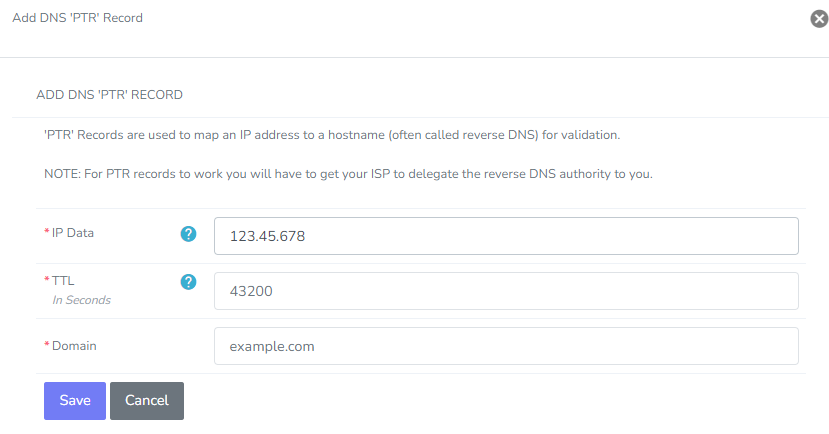
A PTR record maps an IP back to a hostname, often referred to as “Reverse DNS”. This is, essentially, the opposite of an A record–instead of pointing the domain to an IP address, this record points the IP address to the domain.
The format of PTR records are a little strange; the octets of the IP address are reversed, and “.in-addr.arpa” is added to the end. For example if the A record of example.com points to 12.34.56.78, the associated PTR record is 78.56.34.12.in-addr.arpa.
Typically, for security reasons, PTR records are handled by the ISP or data center, so that should always be the first point of contact when it comes to managing PTR records.
Some mail services, such as Google, will not accept mail from domains that do not have an associated PTR record.
Editing or adding a new PTR record requires the following information:
IP Data: The IP address. The IP Data for a PTR record can be entered in several formats:
Normal IPv4 Example: 1.2.3.4
Normal IPv6 Example: beef::12fe
Hostname Example: 4.3.2.1.in-addr.arpa
RFC4183-style Example: 4.3/29.2.1.in-addr.arpa
TTL: The number of seconds that a record will be considered valid by a server caching the information
Domain: The domain associated with the record
SPF Record¶
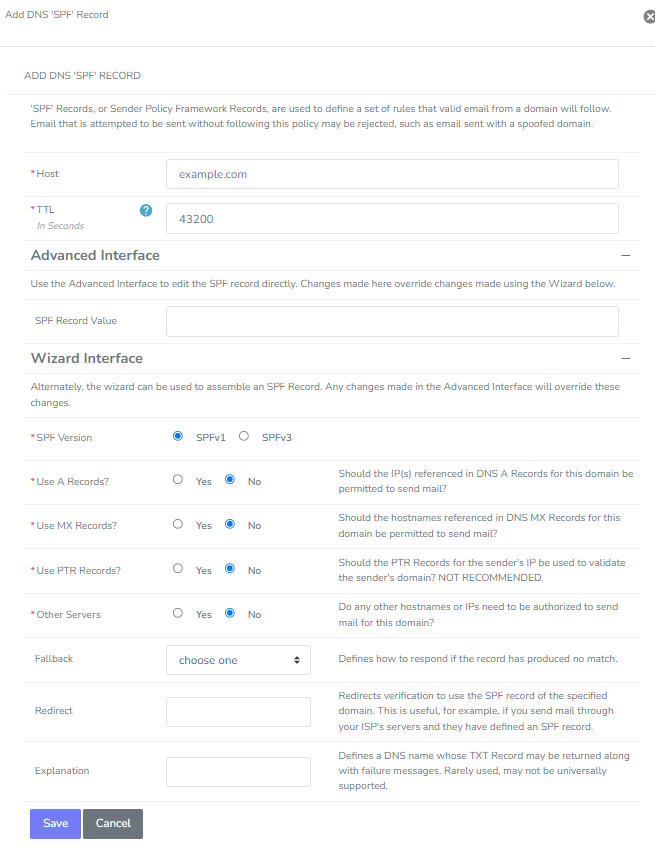
An SPF record, or “Sender Policy Framework” record, is used to define a set of rules that valid email sent from a domain will follow. Email that is attempted to be sent without following this policy may be rejected, such as email sent with a spoofed domain.
Some mail services, such as Google, will not accept mail from domains that do not have an associated SPF record.
Detailed information on SPF record settings may be found here.
Editing or adding a new SPF record requires the following information:
Host: The domain associated with the record
TTL: The number of seconds that a record will be considered valid by a server caching the information
Policy Information: This can either be directly provided using the Advanced Interface or generated using the included Wizard Interface
TXT record¶
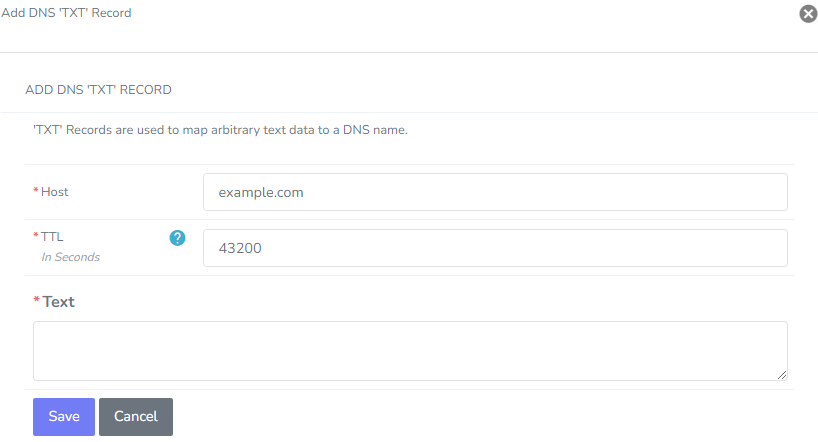
A TXT record holds various extra information about a zone. Records commonly set as TXT records included SPF, DKIM, and DMARC.
TXT records can hold any arbitrary human-readable to be distributed over DNS.
Editing or adding a new TXT record requires the following information:
Host: The domain associated with the record
TTL: The number of seconds that a record will be considered valid by a server caching the information
Text: The contents of the record
SOA (State of Authority) Record¶
The SOA record contains information that is required for all DNS zones. This includes the primary nameserver, contact email, refresh time, retry time, expire time, and minimum TTL (time to live) for the zone.
This record will always be automatically generated when creating a SiteWorx account. Editing this file is not recommend, as doing so incorrectly may cause DNS to no longer function for the domain.